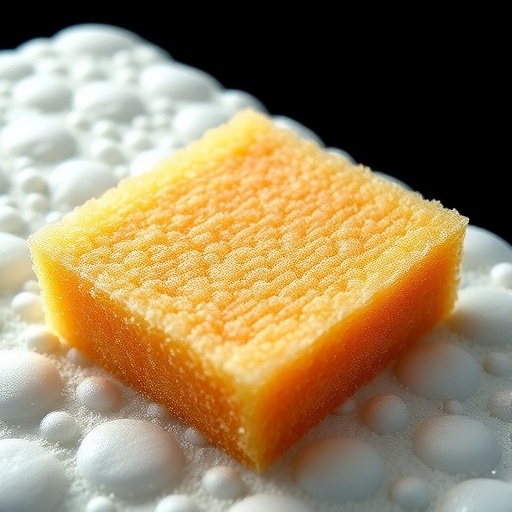In the realm of surgical emergencies, uncontrollable internal bleeding ranks among the most life-threatening complications, particularly involving delicate and highly vascular organs like the liver and spleen. Traditional approaches to hemorrhage control frequently struggle to achieve rapid and reliable hemostasis, especially in scenarios where patients are anticoagulated or when bleeding sites are irregular and difficult to access. Addressing this critical medical challenge, a pioneering research team at Pohang University of Science and Technology (POSTECH) has engineered a groundbreaking composite bioabsorbable hemostatic sponge. This innovative material promises a transformative impact on surgical hemostasis by combining rapid clotting capacity, strong adhesive properties, and safe biodegradability.
The core innovation within this composite sponge lies in the synergy of mussel adhesive protein with a decellularized extracellular matrix (dECM). Mussel adhesive proteins are renowned for their remarkable ability to adhere strongly to wet and dynamic biological surfaces, drawing inspiration from mussels’ natural anchorage to ocean rocks. By harnessing this unique bioadhesive trait, the researchers enabled the sponge to firmly attach to bleeding tissue, mitigating the risk of displacement and improving hemorrhage control even under challenging physiological conditions.
Complementing the mussel adhesive protein, the decellularized extracellular matrix serves a dual function pivotal to wound management. Extracted from biological tissues and processed to remove immunogenic cellular components, the dECM retains a complex network of structural proteins and signaling molecules. This scaffold not only supports natural tissue regeneration but also activates intrinsic coagulation pathways within the body. Such activation accelerates the formation of stable blood clots, facilitating rapid cessation of bleeding while promoting an environment favorable for tissue repair and recovery.
When deployed on a hemorrhagic site, the absorbable hemostatic sponge performs multiple critical functions simultaneously. It immediately absorbs blood, swelling to fill the wound cavity and establishing a physical barrier against further blood loss. Concurrently, its strong adhesive characteristics ensure intimate contact with the tissue, enhancing mechanical stabilization and preventing detachment. Over time, as the body’s natural healing cascades progress, the sponge biodegrades safely without eliciting the secondary complications often associated with non-resorbable materials, such as chronic inflammation or foreign body reactions.
The research team rigorously evaluated the hemostatic efficacy of this composite sponge using an anticoagulated liver injury model, simulating a clinically relevant scenario where patients are administered blood thinners like warfarin. In this demanding context, the sponge exhibited superior adherence to injured tissue surfaces and dramatically shortened bleeding times compared to conventional hemostatic agents. Quantitative measurements demonstrated significant reductions in total blood loss, highlighting its potent capacity to control hemorrhage even in impaired coagulation states.
Beyond hemostasis, the sponge distinguished itself by minimizing local inflammatory responses and tissue damage. Conventional hemostatic agents often provoke adverse tissue reactions due to foreign material persistence, impeding wound healing and sometimes necessitating complex secondary interventions. In contrast, the composite sponge’s biocompatibility facilitated a favorable healing milieu, promoting wound stabilization and early stages of tissue regeneration. This dual role in mitigating bleeding while fostering recovery underscores the clinical potential of this material as a next-generation surgical adjunct.
From a materials science perspective, the integration of mussel adhesive protein with the dECM matrix represents a thoughtfully engineered biohybrid design that leverages nature’s principles to solve clinical problems. This compositional synergy not only enhances physical properties—like adhesion and flexibility—but also introduces bioactivity intrinsic to the ECM components, allowing the sponge to interact dynamically with biological systems. This contrasts starkly with purely synthetic materials, which often lack such biofunctional attributes and can pose long-term compatibility challenges.
Professor Hyung Joon Cha, who spearheaded this research effort at POSTECH, emphasizes the profound implications of this development. By enabling swift and secure bleeding control even in severe internal injuries notoriously difficult to manage, the sponge holds the promise to transform trauma care and operative procedures. “Our composite sponge addresses longstanding challenges of adhesion and biodegradability,” he explains. “It has the potential to reduce the need for repeat surgeries and support faster patient recovery, substantially improving clinical outcomes.”
The collaborative study featured interdisciplinary contributions from chemical engineering and mechanical engineering departments at POSTECH, showcasing how convergent approaches in engineering and life sciences catalyze revolutionary biomaterial innovations. Graduate student Hyegyo Cha played a key role in experimental design and characterization, aiding the thorough investigation published recently in the journal Advanced Healthcare Materials. This publication serves as a testament to the material’s novelty and translational promise within the biomaterials community worldwide.
Financial support from the National Research Foundation of Korea and the Alchemist Project further facilitated this investigation, highlighting the prioritization of advanced biomedical technologies by governmental science and industry agencies. Looking forward, the team envisions continued development toward clinical translation, including scaled-up production, regulatory evaluation, and integration into surgical protocols for internal bleeding management.
Ultimately, this absorbable adhesive composite hemostatic sponge exemplifies a significant leap in hemostatic technology. By amalgamating potent adhesive mechanics derived from mussel proteins with the regenerative capacity of decellularized extracellular matrices, the sponge offers a sophisticated solution capable of redefining standards of care for hemorrhage control. Its multifaceted capabilities promise not only enhanced survival rates but also improved quality of life for patients facing severe internal bleeding, marking a new era in surgical biomaterial science.
Subject of Research: Development of a bioabsorbable adhesive composite hemostatic sponge for internal bleeding control.
Article Title: Absorbable Adhesive Composite Hemostatic Sponge Based on Decellularized Extracellular Matrix and Mussel Adhesive Protein for Internal Bleeding Control.
Web References: DOI link
Image Credits: POSTECH
Keywords: Hemostatic sponge, mussel adhesive protein, decellularized extracellular matrix, internal bleeding, bioabsorbable materials, hemostasis, tissue adhesion, biomaterials, wound healing, surgical hemostatic agents, liver injury model, biocompatibility.
Tags: adhesive properties in wound managementadvanced bioadhesive technologiesbioabsorbable hemostatic spongebiomedical engineering advancementsdecellularized extracellular matrix applicationshemorrhage control in delicate organshemostatic agents for anticoagulated patientsinternal bleeding control solutionsmussel adhesive proteinrapid clotting materials in surgerysurgical hemostasis innovationstransformative surgical materials





